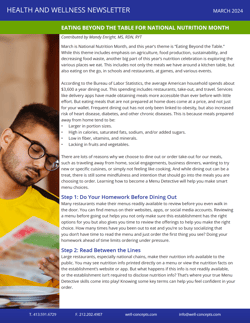March 2024 Corporate Newsletter: Eating Beyond the Table for National Nutrition Month
EATING BEYOND THE TABLE FOR NATIONAL NUTRITION MONTH
Contributed by Mandy Enright, MS, RDN, RYT
March is National Nutrition Month, and this year’s theme is “Eating Beyond the Table.” While this theme includes emphasis on agriculture, food production, sustainability, and decreasing food waste, another big part of this year’s nutrition celebration is exploring the various places we eat. This includes not only the meals we have around a kitchen table, but also eating on the go, in schools and restaurants, at games, and various events.
According to the Bureau of Labor Statistics, the average American household spends about $3,600 a year dining out. This spending includes restaurants, take-out, and travel. Services like delivery apps have made obtaining meals more accessible than ever before with little effort. But eating meals that are not prepared at home does come at a price, and not just for your wallet. Frequent dining out has not only been linked to obesity, but also increased risk of heart disease, diabetes, and other chronic diseases. This is because meals prepared away from home tend to be:
- Larger in portion sizes.
- High in calories, saturated fats, sodium, and/or added sugars.
- Low in fiber, vitamins, and minerals.
- Lacking in fruits and vegetables.
There are lots of reasons why we choose to dine out or order take-out for our meals, such as traveling away from home, social engagements, business dinners, wanting to try new or specific cuisines, or simply not feeling like cooking. And while dining out can be a treat, there is still some mindfulness and intention that should go into the meals you are choosing to order. Learning how to become a Menu Detective will help you make smart menu choices.
Step 1: Do Your Homework Before Dining Out
Many restaurants make their menus readily available to review before you even walk in the door. You can find menus on their websites, apps, or social media accounts. Reviewing a menu before going out helps you not only make sure this establishment has the right options for you but also gives you time to review the offerings to help you make the right choice. How many times have you been out to eat and you’re so busy socializing that you don’t have time to read the menu and just order the first thing you see? Doing your homework ahead of time limits ordering under pressure.
Step 2: Read Between the Lines
Large restaurants, especially national chains, make their nutrition info available to the public. You may see nutrition info printed directly on a menu or view the nutrition facts on the establishment’s website or app. But what happens if this info is not readily available, or the establishment isn’t required to disclose nutrition info? That’s where your true Menu Detective skills come into play! Knowing some key terms can help you feel confident in your order.
Words we want to watch for and consume less frequently at meals, as they can signal menu items that are higher in calories, saturated fat, sodium, or added sugars. While you don’t have to skip these items completely, you do want to be mindful of your portion sizes:
|
A la mode |
Alfredo |
Au gratin |
Battered |
Breaded |
Buttery |
|
Cheesy |
Creamy |
Crispy |
Crusted |
Deep-fried |
Fried |
|
Fritter |
Glazed |
Golden |
Smothered |
Tempura |
These are words we want to consider more when dining out. They tend to be lower in calories and fat, but still be mindful of sodium or added sugars, especially when it comes to condiments such as sauces and dressings.
|
Baked |
Boiled |
Broiled |
Fresh |
Grilled |
Poached |
|
Roasted |
Rubbed |
Sauteed |
Seared |
Seasoned |
Spiced |
|
Steamed |
Stir-fried |
Step 3: Watch Portion Sizes
Restaurants are notorious for large portion sizes because people want to feel they are getting value for their money. And while you can’t always control the ingredients in your meals while dining out, you certainly have a say in portion sizes.
- A rule of thumb is to aim for half of your plate to contain vegetables (or a combination of vegetables and fruit), ¼ protein, and ¼ of a high-fiber carbohydrate.
- If more than that shows up at your meal, ask for a to-go box so you can bring the rest home to have at another time.
- Consider ordering appetizers instead of a main dish to enjoy smaller portions.
- If you’re ordering takeout, plate your meal instead of eating directly out of a container.
Step 4: Add a Boost of Produce
Many restaurant meals tend to be mostly protein and carbohydrates with few vegetables or fruit, so here are some ways you can boost up your produce when dining out:
- Ask for a side salad, vegetable, or fruit instead of a side of fries or potatoes.
- Top a sandwich with extra vegetables.
- Appetizers tend to be where you can find the most vegetables and fruit, so consider ordering a salad, soup, or colorful appetizer to start or have in place of your main meal.
Want to dive into these heart healthy habits further? Contact Wellness Concepts by visiting well-concepts.com to set up employee wellness sessions including nutrition and sleep seminars, cooking demos, fitness classes, and stress management sessions that will help reinforce these heart health habits.
ENJOY EATING BEYOND THE TABLE THIS NATIONAL NUTRITION MONTH!
![]()
Mandy Enright MS, RDN, RYT, is a Registered Dietitian, Yoga Instructor, and Corporate Wellness Expert, as well as main content contributor for Wellness Concepts. Mandy is a featured presenter, both virtually and onsite near her home in Neptune, NJ.
March 2024 Corporate Newsletter: Eating Beyond the Table for National Nutrition Month


